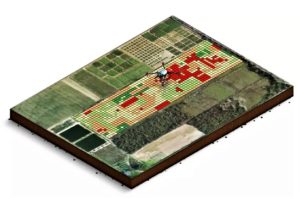Leveraging AI Technology to Transform Agriculture
XAG, a Chinese agri-tech company, presented its innovative solutions at the recent AI for Good Global Summit held in Geneva (May 28-31, 2019). XAG combines drones with AI and IoT technology to achieve precision agriculture and induce transformational changes to the food system. XAG has set up laboratories and research stations in 20 countries, including Japan, Australia, New Zealand, Germany, United States, United Kingdom, Indonesia, Thailand, Myanmar, Peru, Ecuador, etc., and participated in a number of frontier agri-tech projects.
This was the third summit which is a leading United Nations platform for multilateral dialogue on Artificial Intelligence (AI). Bringing together over 1,200 interdisciplinary participants from 200 countries, the AI for Good Global Summit connected AI innovators with problem owners to identify practical applications of AI to accelerate process towards the United Nations Sustainable Development Goals (SDGs). Speakers from industry giants such as Microsoft, Google, Mastercard, IBM, Airbus, Siemens, Danone and Roland Berger were present at the Summit.
“Zero Hunger” is one of the 17 UN SDGs (Sustainable Development Goals) expected to be achieved by 2030. According to the United Nations, up to 80% of food consumed in most developing countries is produced by small farm owners who, however, account for approximately 50% of the 815 million people suffering from hunger worldwide.
At the Summit’s session on AI and Agriculture, Justin Gong, Co-founder and Vice President of XAG, together with other panel experts from Microsoft, Tata Group and Connecterra proposed projects and initiatives to exploit new possibilities of AI technology to improve food security and end hunger.
Make AI-driven Precision Agriculture Practical
Artificial Intelligence, through analysing massive data whilst designing and optimising algorithms, can help farmers diagnose plant diseases, predict natural disasters and employ appropriate resources to close the yield gap. At XAG, drones and sensors have been leveraged to establish digital farming infrastructure in rural areas and enable precision agriculture which can accurately target pesticides, seeds, fertilisers and water to wherever it is needed.
“The diffusion of AI innovations is nonlinear,” said Justin Gong. “Unlike releasing new drugs or medicine which would totally disrupt the market, AI technologies are learning from countless applications and gradually entering our daily life.”

XAG has conducted UAS (unmanned aerial system) plant protection services on over 6 million hectares of farmland, covering 255 crop varieties from rice and wheat to cotton and fruit trees. This has reduced more than 6000 tons of pesticides and fertilisers while conserving 1.4 million tons of agricultural water. The agricultural production data collected during the process will also train XAG Agriculture Intelligence (XAI) to become smarter.
XAI has been developed to dig up the values behind field images and generate AI prescription maps to assist high-precision operation. In the case of orchard management, farmers use XMission Multifunctional UAS mounted with a mapping camera to take high-definition images of the orchards. Based on the 1:500 HD field images, XAI can automatically identify the boundaries and obstacles as well as calculate the statistics of fruit trees in each orchard. The position of each fruit tree, including its centre and perimeter, can be accurately pinpointed, with the recall ratio and precision ratio reaching as high as 98.60% and 98.04% respectively. Thousands of fruit trees can be simultaneously located by XAI in only one second.
When analysing remote sensing images, XAI can go further to detect pests, weeds and diseases, recognise cotton ball opening rates as well as monitoring crop growth. This enables and provides intelligent guidance for precision spraying.

Business Model Innovation Comes Along with AI and Drone
Through the development of Agriculture Intelligence, XAG has also driven collaboration between multi-stakeholders including farmers, service providers and traditional agriculture companies to promote a new business model that benefits all. As Gong presented, the cotton production business in Xinjiang, China has been disrupted by the diffusion of AI and drone technology. Compared to hand picking cotton in the past, local farmers now use ground-based machines such as tractors to harvest cotton. In order to ensure a better-quality machine harvest, farmers traditionally sprayed multiple defoliant to remove all the cotton leaves. This approach caused overdosing which wastes a large amount of water and chemicals.
With four years’ field experiments on deep learning, image segmentation and convolutional neural networking, XAG has taken the lead in utilising drones and AI to reduce defoliation. A large-scale cotton defoliation operation has been initiated in Xinjiang in autumn 2018. XAI predicts the cotton opening time and determines the best time to conduct spraying, through the analysis of meteorological data and the cotton growing status. Then, the amount of defoliant needed for different patches of land is calculated to form an AI prescription map and enable precision spraying.
This has changed the game for agriculture production. In the past, farmers heavily relied on chemical distributors to decide what to buy and how much should be applied to the crops. Now with new technologies bridging the gap, the traditional chemical distributors can provide a more reliable, guaranteed service based on the AI prescription map. As for big players such as Bayer, one of the biggest agrochemical producers, has partnered with XAG in developing UAS-specialised chemicals and delivering safer, more cost-effective plant protection service to farmers.
AI-backed Digital Finance for Small Farm Owners
XAG is trying to solve the lack of financial resources in the rural regions of developing countries. Small farm owners are dedicating their lives to producing food for the world, but without financial support to adopt new tools and approaches – most of them can hardly make ends meet on their land.
Now with information on farming, crop growth and transactional records being digitalised and shared, AI can be harnessed to build individual credit risk scoring systems for farmers. In China, XAG has established strategic cooperation with some of the biggest national financial institutions to offer farmers, even those without credit cards or collateral, convenient, equal access to loans and claims. Based on their accumulated digital credits earned from Alipay mobile payment, farmers and service providers can even rent the P Series drone without any deposit. This is making new technologies available to a broader group of small farmers, while helping them obtain necessary resources to improve productivity and generate decent incomes.
AI is making an impact on agriculture, despite legal and ethical challenges associated with its adoption. Justin Gong added, “there are huge opportunities for the world, especially the developing countries, to adopt flexible, nimble technologies such as AI and drones to grow food more sustainably.”
Source: XAG